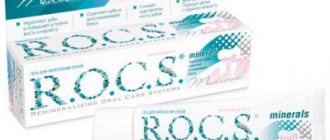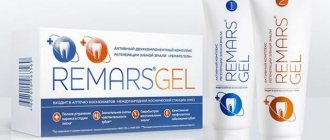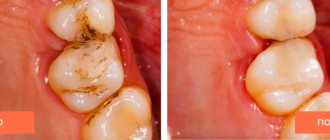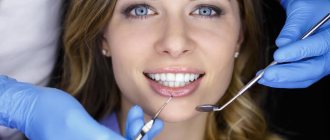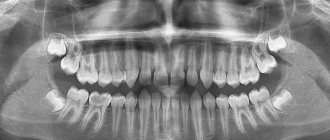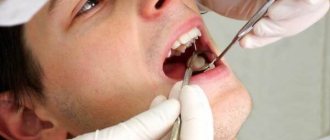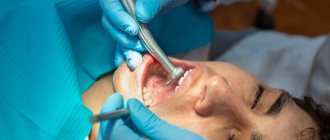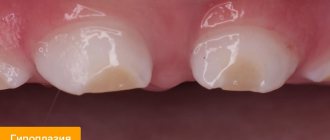Modern dentistry demonstrates a number of persistent trends, including: painlessness, focus on preventive effects, the use of the most gentle techniques and the desire to avoid preparation procedures.
All these trends are fully consistent with the innovative method of treating carious formations - Icon.
The name of this technology comes from the merger of two terms - Infiltration CONcept, which translated from English means “infiltration concept”.
This method was developed and patented in 2008 by German dentists, after which it was successfully tested in many European countries, as well as in the USA and Japan. The procedure was able to successfully replace the previously widely used fluoridation technique due to its superiority.
Essence of the procedure
The basic principle of infiltration is the use of special substances to treat cavities caused by caries. This method is called microinvasive - one that has a minimal degree of penetration into dental tissue.
The developer, DMG Corporation (Germany), proposes to get rid of caries stains not by mechanical (drilling), but by chemical (dissolving and blocking) methods. We are talking specifically about the treatment of caries, and not about simple lightening of the surface of the teeth, which belongs to the field of aesthetic dentistry.
The Icon infiltrant gel, specially synthesized by scientists, is a special polymer substance with a viscous structure. Outwardly it evokes an association with the texture of resin, but of a different color. The gel is applied to the surface of the tooth and penetrates the enamel. After this, the activation of its action begins. The gel eliminates lesions, blocks further spread of the disease and “seals” the enamel. The infiltrating polymer helps neutralize cariogenic acids that cause destruction of the tooth body.
In the process of using the infiltration substance, remineralization of the carious surface occurs. Damaged areas are healed, and healthy areas receive additional prevention for the future.
The enamel, which under the influence of caries has acquired a porous structure and has become fragile, is strengthened after using the gel. Particles of the infiltrating substance fill the pores, making the tooth insensitive to adverse environmental factors.
Main functions of infiltration gel:
- destruction of carious formations;
- preventing their further spread;
- improvement of the general condition of tooth enamel.
The Icon method is suitable for the treatment of vestibular and proximal surfaces. After the procedure, the teeth look natural: their natural shape does not change, a uniform color remains, stains and painful formations disappear.
The entire process takes place without pain or discomfort, so patients do not need to use anesthetic drugs. This makes it possible to use the infiltrating gel in the treatment of people who, due to their age, special health conditions or allergies, are forced to refuse pain relief during routine dental procedures.
The infiltrating substance has a good effect not only on molars, but also on baby teeth, so treatment with Icon gel can be prescribed even to small children. The effectiveness of the technique is more than 80%. This is precisely the indicator of cases where it was possible to avoid further development of caries and tissue destruction after one infiltration treatment procedure.
What are caries?
Caries is the general name of a pathological process when, under the influence of various factors, the process of demineralization of enamel and destruction of dental tissue occurs. Caries goes through several stages.
- White spot stage.
This is the very initial stage when a small focus of demineralization appears on the surface of the tooth enamel. It looks like a light spot, does not cause any discomfort to a person and may not be noticeable for a long time. However, a carious stain means that the enamel loses minerals, becomes thinner, more permeable, and therefore vulnerable to the negative effects of bacteria.
- Dark spot stage.
This is still an early stage of caries development, but the loss of minerals is already more significant. The stain takes on a dark shade, and a person can independently notice it on the teeth during the next brushing.
- Stage of superficial caries.
At this stage, instead of a stain, a carious cavity appears in the tooth enamel.
- Medium and deep caries.
The carious lesion penetrates into the bone tissue of the tooth - dentin, in which a cavity is formed. Deep caries is located as close as possible to the pulp and dental nerves; if left untreated, it can develop into pulpitis. Depending on the stage of caries, different treatment methods may be used.
Advantages
The developers of Icon technology set themselves the goal of providing the ability to treat caries without the use of drilling equipment. This is the key advantage of the innovative technology, which avoids pain and surgical intervention in the treatment of caries.
The main advantages of the Infiltration CONcept technique:
- minimizing physical and psychological discomfort for the patient;
- gentle effect that does not cause damage to healthy tooth tissues;
- the ability to get rid of carious formations without drilling;
- suitable not only for adults, but also for the youngest patients with caries;
- can be used in hard-to-reach places that are difficult to reach during treatment with a drill;
- You can get rid of caries in one visit to the dentist;
- The infiltration procedure itself takes about 20-25 minutes;
- after treatment, the natural shape of the tooth is completely preserved;
- no need for filling.
After using the special infiltration gel Icon, not only the healing of diseased teeth is observed, but also the improvement of the condition of healthy ones. They become stronger, less susceptible to destructive factors - for example, sweet foods.
Due to its wide range of advantages, painlessness and short duration of action, the use of the Icon method is indicated for the treatment of caries in children in whom drills and other dental equipment cause panic. Applying a unique gel to sore areas does not cause pain or fear in children.
Icon and caries: how does it work?
The name Icon is an acronym for Infiltration Concept. This is a technology that was developed in Germany and in a short time gained popularity around the world. Treatment of caries using the Icon infiltration method occurs without the use of a drill, and this is its main innovative component. Using special tools and auxiliary solutions, a polymer solution is applied to the tooth, which hardens under the influence of ultraviolet radiation. It destroys pathogenic bacteria, seals the carious area and restores enamel density. In general, the infiltration system is a set that includes:
- Instruments (syringes and attachments for working with vestibular and proximal surfaces of teeth, interdental wedges);
- Icon-etch etching gel, which contains hydrochloric acid;
- Icon-Dry conditioner, used to dry the tooth after gel treatment;
- Infiltration material (treatment of caries without preparation Icon is based largely on its properties).
Indications
The main indication for using the infiltration method is caries in the initial stage.
Applying a disinfecting gel is also recommended after removing braces. This treatment procedure is often accompanied by the appearance of specific dark spots on the enamel. Icon's innovative technology helps not only to cure the area affected by caries, but also to lighten tooth enamel in places where it is darkened.
Another indication is the need to treat hard-to-reach places on the tooth, the interdental space. Sometimes the lesion reaches areas where drilling is impossible. The application of the gel is not limited to the visible side of the teeth, so it can be used to treat even the side and back walls, as well as microscopic cracks and chips.
Treatment of carious diseases using infiltration treatment is indicated even when other methods cannot be used, for example, if a pregnant patient contacts the dentist.
The material operates on the principle of infiltration
You've probably already heard that Icon is a method that modern dentistry offers today for the treatment of caries. What is Icon? The word comes from the acronym Infiltration Concept, which means “infiltration concept.” For doctors, everything is clear here, plus they have instructions from the manufacturer, according to which they act. But how can a patient who does not understand what the essence is and what the word “infiltration” means decide to undergo this procedure? Let's figure it out together.
Icon is a method that modern dentistry offers today for the treatment of caries
If we take the term literally, it means seepage, saturation of the fabric with some substance that gets on it from the outside. In dentistry, this involves applying a special dental material, for example, Icon Infiltrant, to the lesion. It is created on the basis of hypoallergenic synthetic resins and penetrates well into tissues, literally seals or clogs the enamel pores from cariogenic bacteria and thereby stops the development of the pathological process and further tooth destruction.
The material is liquid (which is why it is sometimes called a liquid filling). To make it harden, the doctor uses a polymerization lamp.
The drug hardens using a polymerization lamp
Contraindications Icon
The list of contraindications to the use of the Ikon procedure is limited. It includes:
- special cases of allergic reactions to one of the components of the substance;
- presence of defects in tooth enamel;
- too deep lesions that have reached the deep layers of dentin;
- the child's age is less than three years;
- fluorosis
If serious violations of tooth enamel are detected, the use of the gel will not give the desired effect and may cause pain to the patient. Therefore, for advanced cases of caries, it is better to use classical techniques that require drilling.
Overview of non-drilling treatment methods
Thanks to the improvement of the scientific and technical base, dentists now have tools to combat caries, with which they can remove affected tissue without affecting the healthy part of the tooth and without drilling with drills. Processing methods differ depending on the technology used. However, most “alternative” procedures to drilling are effective in the initial stages of the carious process.
The methods indicated for the superficial form of the disease in most cases prevent and stop caries. Thanks to their appearance, there is no need to “delay until the last minute”, postponing a visit to the doctor until pain appears. Prevention and timely minimally invasive sanitation for caries helps to save the tooth, avoid treatment that requires anesthesia and spend time in the dental office without stress and discomfort.
The most common and mastered methods of combating caries without drills include:
- laser method - therapy based on the fluorescent effect of a thin beam on the affected area;
- ozone treatment - neutralization of infection with gas is used as an independent procedure, a stage in the treatment of cavities in teeth or the prevention of caries;
- air-abrasive impact on the area with caries using special tips and compounds;
- infiltration - treatment of a carious spot with polymer compounds.
Features of the procedure
Technologically, the process of caries treatment using Icon is carried out in stages:
- mechanical cleaning of the tooth surface is performed;
- bacterial plaque is removed;
- a special latex plate is placed on the teeth to isolate them;
- Dental wedges are used to reach hard-to-reach areas;
- the diseased area is treated with a disinfectant;
- holding time – three minutes;
- the gel is washed off with water;
- The tooth enamel is dried using a stream of air.
At the final stage, the cleaned areas are treated with a polymer substance and illuminated under a lamp. The finishing touch is grinding the tooth surface.
The entire Icon procedure usually takes no more than half an hour and does not require the patient to return to the dental office.
After finishing the work, the dentist must instruct the patient about the specifics of oral care. Post-procedure requirements are minimal: it is enough to refrain from smoking and drinking coloring drinks (tea, coffee) for the next two to three hours.
What is icon technology
The concept of infiltration - this is how InfiltrationConcep (icon) is translated from English.
Leading specialists from the German concern DMG worked on the invention and improvement of this method of caries treatment. It was almost immediately adapted to dental clinics in Europe, and after a short interval of time it reached domestic dentistry.
Icon is a minimally invasive method of treating caries, based on the integration of a polymer solution into the carious cavity. The main practical purpose of such a composition is to seal the affected area. It is in this way that the restoration of the tooth surface is achieved and makes it resistant to aggressive and acidic environments.
Flaws
Like any other, even the most innovative technology, Icon has a number of disadvantages. They do not negate the positive impression of this method of treatment, but must be taken into account for its correct use.
Firstly, infiltration is not effective if carious lesions develop intensively and reach the internal tissues of the tooth.
Secondly, infiltration gel can only be used on a smooth surface; the presence of deep cracks and chips is unacceptable.
Thirdly, working with infiltration equipment requires special training of the dentist. Otherwise, Icon treatment may not be effective. In addition, incorrect assessment of the extent of carious damage can lead to penetration of the gel all the way to the nerve.
The last drawback of the Icon method relates to the economic component of the procedure. Due to its innovation, it remains expensive, so it is not yet very popular.
Recommendations for use
Treatment of proximal surfaces with Icon Kariesinfiltrant – approximal
- Before treatment, clean the tooth being treated and adjacent teeth. After cleaning, remove all residues with a water jet. Apply rubber dam.
- Insert one of the supplied spacer wedges into the space between the teeth. In order for the wedge to better enter the proximal part, its handle can be rotated at an angle. — For the necessary separation of the teeth, the wedges must be inserted to a sufficient depth of the interdental space. – To ensure successful treatment, the teeth must be separated by approx. at 50 µm. This can be done in stages: insert the wedge until you feel resistance. Wait 3-5 seconds, then gradually insert the wedge deeper until the widest part of the wedge sufficiently separates the teeth. — Leave the separating wedge in the proximal space throughout the procedure.
- Screw the proximal tip onto the Etch syringe and insert the tip into the interdental space. In this case, the green side of the proximal nozzle should be directed towards the surface being treated. — The material comes out only from the green side of the film. Carefully! Improper use of Etch may cause pain to the patient. — Icon-Etch should only be used on enamel. Do not use on exposed dentin or filled areas.
- Apply Etch with a small excess to the affected area. 1.5 - 2 turns of the piston approximately correspond to the required amount of material. Leave Etch on for 2 minutes. If necessary, remove large excess material. — The syringe is controlled with one hand.
- Remove the application film from the interdental space. Suction off the Etch and rinse with water for at least 30 seconds. Then dry with dry air from an oil-free compressor.
- Screw the tip (needle) onto the Dry syringe, apply the material with a slight excess to the affected area and leave to act for 30 seconds. Then dry with dry air from an oil-free compressor. — Do not apply Icon-Infiltrant under direct light from a dental light as this may cause premature polymerization of the material.
- Screw the new proximal tip onto the Icon-Infiltrant syringe and insert the tip into the interdental space. In this case, the green side of the proximal nozzle should be directed towards the surface being treated. — The material exits only from the green side of the proximal nozzle.
- Apply Icon-Infiltrant with a slight excess to the affected area. 1.5 - 2 turns of the piston approximately correspond to the required amount of material.
- Leave Icon-Infiltrant to act for 3 minutes, adding material if necessary.
- Remove the attachment from the interdental space. Remove excess material using dental floss.
- Illuminate Icon-Infiltrant from all directions for at least 40 seconds.
- Screw the new proximal tip onto the Icon-Infiltrant syringe and apply the material a second time (steps 7-8) and leave for 1 minute. Remove the attachment from the interdental space. Remove excess material using dental floss. Then illuminate the material from all sides for at least 40 seconds.
- If the next affected area is treated during the same treatment session, repeat steps 1 to 12.
- Remove the separating wedge and rubber dam. Surface polishing is carried out using strips.
Treatment of vestibular surfaces with Icon Kariesinfiltrant – vestibular
- Before treatment, clean the tooth being treated and adjacent teeth. After cleaning, remove all residues with a water jet. Apply rubber dam.
- Screw the smooth surface attachment onto the Etch syringe. Carefully! Improper use of Etch may cause pain to the patient. — Icon-Etch should only be used on enamel. Do not use on exposed dentin or filled areas.
- By turning the plunger, carefully apply Icon-Etch with a slight excess to the affected area and leave to work for 2 minutes. If necessary, remove large excess material with a cotton swab. — The syringe is controlled with one hand. Note: If treatment of white spots is carried out later than 1-2 months after removal of braces, etching should be carried out twice. If the white spot is still visible after applying Icon-Dry, a third etching is recommended.
- Remove by aspirating Etch and rinse with water for at least 30 seconds. Then dry with air from an oil-free compressor.
- Screw the tip (needle) onto the Icon-Dry syringe, apply the material with a slight excess to the affected area and leave to act for 30 seconds. Then dry with dry air from an oil-free compressor. Note: When Icon-Dry is wetted, the whitish-matt color of the enamel will become less pronounced. If this does not happen, the etching process should be repeated a second and third time (two minutes each) and the surface of the teeth should be rinsed and dried again (step 3-5).
- Screw the new vestibular attachment onto the Icon-Infiltrant syringe. — Do not apply Icon-Infiltrant under direct light from a dental light as this may cause premature polymerization of the material.
- Rotate the plunger and apply Icon-Infiltrant in a slight excess to the etched surface.
- Leave Icon-Infiltrant to act for 3 minutes. Remove excess material with a cotton swab and, if necessary, dental floss.
- Illuminate Icon-Infiltrant for at least 40 seconds.
- Screw a new vestibular attachment onto the Icon-Infiltrant syringe, apply the material a second time (steps 7-8) and leave for 1 minute. Remove excess material with a cotton swab and, if necessary, dental floss. Then shine for at least 40 seconds.
- Remove rubber dam. Surface polishing is carried out using, for example, strips.
Ozone treatment
Ozone is an effective bactericidal agent. It is used in the treatment of the initial stages of the carious process, cervical, fissure and root forms of the disease. The technique used in dentistry was developed by British specialists and in some cases of caries makes it possible to do without filling. The gas produced from oxygen destroys the shells of viruses and bacteria, causing them to die. The oxidation that accompanies the transition of ozone back to oxygen is harmless to healthy tooth tissue and the oral cavity.
Treatment is carried out by placing a small cap on the area affected by caries, in which a vacuum is created. The directed flow of ozone suppresses microorganisms and promotes remineralization of dental tissue. Drilling and anesthesia are not required, the procedure lasts up to 40 seconds and is not accompanied by unpleasant sensations. Despite the high price of ozone therapy, people turn to it because of its benefits:
- the treatment is harmless to the child’s body and is allowed during pregnancy (does not affect the expectant mother or fetus);
- the drugs used in treatment are hypoallergenic and do not irritate the oral mucosa;
- the method is effective in preventing caries (although ozone cannot cope with deep lesions).
Laser method
Dentists have different views on treatment using laser devices, but most experts agree that it is effective in the early stages of caries. The main advantage of the method is the absence of vibration and thermal effects, which cause such familiar unpleasant sensations when drilling. The drill, which rubs against the enamel and dentin, heats up and provokes pain. Vibration is added to it, increasing discomfort. This is not the case with a laser.
The beam has a narrowly targeted effect on the area affected by caries; during treatment there is no heating (the radiation power is low) or pressure on the teeth. The installation is almost silent, and the effect is sterile - the tip does not come into contact with the tooth surface. The beam suppresses the growth of microorganisms that cause caries; microcracks do not appear because of it, and healthy tissues do not suffer. The treatment does not require pain relief, does not cause the slightest discomfort, and is indicated for young children and pregnant women.
The method is also effective in diagnosis, for detecting affected cavities. Its disadvantages include:
- increased demands on dentists - due to the complexity of working with a laser, treatment can only be carried out by highly qualified professionals;
- the need to use glasses to protect the eyes - they are worn by both patients and the doctor, which narrows his field of vision and distorts the view;
- slow healing of soft tissues accidentally damaged by a laser beam;
- significant treatment costs due to the high cost of the devices.
